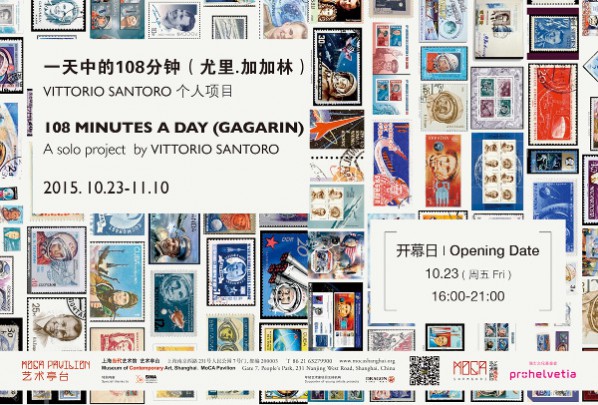
The large-scale installation entitled 108 Minutes A Day (Gagarin) by Italian-Swiss artist Vittorio Santoro was especially conceived for the rectangular space of the MoCA Pavilion. The work takes the form of an architectural intervention including sculptural floor objects and it combines elements of historical research around the first human journey into outer space as well as participatory conversations with more than 90 inhabitants in Hangzhou, among them students of the China Academy of Art of Hangzhou where the artist is presently a visiting artist.
Upon entering the exhibition the viewer is confronted with a vertical chain link fence that extends into the space and divides it diagonally into two distinct sections obliging the viewer to chose between the right or left side. Both sections mirror each other: on each side a wooden board sculpture lies on the floor and conceals specially collected objects under a painted canvas, which is held together by an intricate maze of cords; meanwhile a simple solitary glass, half-filled with water, is positioned in the corner of each section.
The two right angle triangular floor-sculptures contain a collection of objects chosen by people(students, teachers, pedestrians on the streets, shop employees, workers etc.) that the artist and his team have interviewed in the preparation for the installation. The conversations addressed the legacy of the Soviet cosmonaut Yuri A. Gagarin (1934-1968), the first human to have journeyed into outer space, and who orbited the earth in 108 minutes on April 12, 1961 in the fabled Vostok 1 spacecraft. Historically emblematic, Gagarin is a figure divided between the idealistic fervor of a young man compelled to serve agreater cause on one hand and the interests of the Soviet government and its Cold War policy on the other.
The conversations with the participants focused on those kinds of experiences that can be made intelligible only with difficulty because language’s power to express or describe might fail or even collapse in such circumstances. In so doing, Gagarin’s radical 1961 journey into outer space served as a narrative blueprint. With the image of the 108 minutes of the cosmonaut’s flight – who hovered in space in a tiny shuttle at great speed –as a trigger for the conversations, the interviewees were asked to remember an equivalent intense and personal momentin their own lives and to associate an object with it. It is these objects that now are concealed inside the two floor sculptures, where they might function as a plurality of latent, invisible testimonials of something exceeding or transcending language.
To translate such an immaterial moment with a tangible objectis an essential, albeit paradoxicalaspect of Santoro’s project. It points towards individual and collective dimensions of memory and imagination including its more conflicting aspects when individual aspirations and expectations collide with the social machineryand its rules and conventions.
About the work of Vittorio Santoro
Vittorio Santoro’s multi-faceted work comprises sculptures, drawings, installations, works in the public sphere, sound pieces as well as video and filmic works. His works are rooted in everyday observations, but push beyond them to reveal latent historical, aesthetic, socio-political, or even metaphysical realities. His characteristically intricate visual sensibility conceals a tension between the referential possibilities of objects and the choreographic nature of their placement in context. For each work Santoro choses specific ways to generate desired effects believing that creativity is an ongoing process of continual change and reaction. In presenting his work with an obvious but researched artificiality and abstraction without noticeable explanations he ensures that the audience maintainsan objective perspective on it. Santoro is sensitive to the unassuming nature of everyday interactions and through subtle means examines the notion of individual agency as it plays out within larger networks of clichés, common ideals, models of authority, or processes involving manipulation and power.
About the project
Date: 2015.10.23-2015.11.10
Opening Hours: Monday - Sunday 10:00am - 9:00pm
Location: MoCA Pavilion (Gate 7, People’s Park, 231 Nanjing West Road)
Courtesy of the artist and MoCA Pavilion.




























